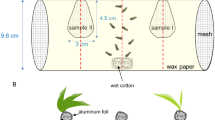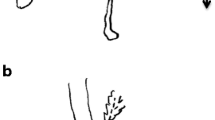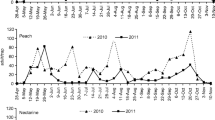Abstract
Coniferous trees of the genus Pinus (Pinaceae) are under continuous threats by numerous herbivorous insect species and pathogens attacking nearly all parts and tissues of the plants. To defend themselves, pine trees produce large amounts of oleoresin that is accumulated in a highly developed network of specialized resin ducts, which are distributed in the wood, bark, and needles. Such defense reactions in pines can be induced by the attack of herbivores. The banded pine weevil, Pissodes castaneus (De Geer, 1775) (Coleoptera, Curculionidae), is an important pest of Pinus in Brazil, where it has been an invasive species since 2001. The female lays its eggs under the tree bark of trees and the larvae feed in the phloem of the trunk and branches, interrupting the sap circulation and eventually causing its death. In the present study, we conducted detailed GC–MS analyses of volatiles emitted by twigs of Pinus taeda L. We analyzed how the attack by P. castaneus males and females affects the volatile pattern emitted by the twigs. When comparing volatiles produced by healthy plants and by female- and male-attacked P. taeda, qualitative and quantitative differences were detected, as the decreased production of limonene, germacrene D and (E)-caryophyllene and the increase of α-pinene. Laboratory bioassays showed that plants attacked by male and female P. castaneus were more attractive to the insects. Understanding about what compounds may attract or repel the insects may help in the development of more effective traps, as well as preventing stress to avoid infestation.



Similar content being viewed by others
Data availability statement
The authors declare the availability of data in the supplementary section of the manuscript.
References
Adams RP (2007) Identification of essential oil components by gas chromatography/mass espectrometry. Allured Publishing Corporation, Illinois
Ahrens S (2000) Manejo e Silvicultura de Plantações de Pinus na Pequena Propriedade Rural. In: Galvão APM (ed) Reflorestamento de Propriedades Rurais Para Fins Produtivos e Ambientais: Um Guia Para Ações Municipais e Regionais. Embrapa Comunicação para Transferência de Tecnologia, Brasília, p 219
Alin L, Sundberg U (2003) Statistical Yearbook of Sweden 2003. Statistics Sweden, Örebro, Sweden
Alquézar B, Volpe HXL, Magnani RF et al (2017) β-caryophyllene emitted from a transgenic Arabidopsis or chemical dispenser repels Diaphorina citri, vector of Candidatus Liberibacters. Sci Rep 7:5639. https://doi.org/10.1038/s41598-017-06119-w
Arimura G, Pearse IS (2017) Chapter one—From the lab bench to the forest: ecology and defence mechanisms of volatile-mediated ‘talking trees.’ In: Becard G (ed) Advances in botanical research. Academic Press, pp 3–17
Ayres M, Ayres Jr. M, Ayres DL, Santos A de AS dos (2007) BioEstat 5.0
Barnola LF, Masahisa H, Cedeño A (1994) Mono- and sesquiterpene variation in Pinus caribaea needles and its relationship to Atta laevigata herbivory. Biochem Sys Ecol 22:437–445
Bedard WD, Tilden PE, Wood DL et al (1969) Western pine beetle: field response to its sex pheromone and a synergistic host terpene, myrcene. Science 164:1284–1285. https://doi.org/10.1126/science.164.3885.1284
Bedini S, Flamini G, Girardi J et al (2004) (2015) Not just for beer: evaluation of spent hops (Humulus lupulus L.) as a source of eco-friendly repellents for insect pests of stored foods. J Pest Sci 88:583–592. https://doi.org/10.1007/s10340-015-0647-1
Bichao H, Borg-Karlson A-KK, Araújo J et al (2003) Identification of plant odours activating receptor neurones in the weevil Pissodes notatus F. (Coleoptera, Curculionidae). J Comp Physiol A 189:203–212. https://doi.org/10.1007/s00359-003-0391-5
Blackmer JL, Rodriguez-Saona C, Byers JA, et al (2004) behavioral response of lygus hesperus to conspecifics and headspace volatiles of alfalfa in a y-tube olfactometer
Bougherra HH, Bedini S, Flamini G et al (2015) Pistacia lentiscus essential oil has repellent effect against three major insect pests of pasta. Ind Crops Prod 63:249–255. https://doi.org/10.1016/j.indcrop.2014.09.048
Cadahia D, Romanyk N, Spain. (1992) Plagas de insectos en las masas forestales españolas. 272 p.
Cardoso JTT, Lázzari SMN (2003) Comparative biology of Cycloneda sanguinea (Linnaeus, 1763) and Hippodamia convergens Guérin-Méneville, 1842 (Coleoptera, Coccinellidae) focusing on the control of Cinara spp. (Hemiptera, Aphididae). Rev Bras Entomol 47:443–446
Chiu CC, Keeling CI, Bohlmann J (2017) Toxicity of pine monoterpenes to mountain pine beetle. Sci Rep 7:8858. https://doi.org/10.1038/s41598-017-08983-y
De Moraes CM, Lewis WJ, Paré PW et al (1998) Herbivore-infested plants selectively attract parasitoids. Nature 393:570–573
Dias PC, Xavier A, de Resende MDV et al (2018) Genetic evaluation of Pinus taeda clones from somatic embryogenesis and their genotype x environment interaction. Crop Breed Appl Biotechnol 18:55–64. https://doi.org/10.1590/1984-70332018v18n1a8
Dicke M, van Loon JJA (2000) Multitrophic effects of herbivore-induced plant volatiles in an evolutionary context. Entomol Exp Appl 97:237–249
El-Shafie HAF, Faleiro JR (2017) Semiochemicals and Their Potential Use in Pest Management. In: Shields VDC (ed) Biological Control of Pest and Vector Insects. InTech, Rijeka, p Ch. 01
Faldt J, Martin D, Miller B et al (2003) Traumatic resin defense in Norway spruce (Picea abies): Methyl jasmonate-induced terpen synthase gene expression, and cDNA cloning and functional characterization of (+)- 3-carene synthase. Plant Mol Biol 51:119–133
Fitzgerald TD (2003) Role of trail pheromone in foraging and processionary behavior of pine processionary caterpillars thaumetopoea pityocampa. J Chem Ecol 29:513–532
Franceschi VR, Krekling T, Christiansen E (2002) Application of methyl jasmonate on Picea abies (Pinaceae) stems induces defense-related responses in phloem and xylem. Am J Bot 89:578–586
Grez OR, Fontecilla LF, Nunez RA, et al (2000) Manual de plagas cuarentenárias potencialmente daninas para o Chile com especial énfasis em plantaciones de pino y eucalipto. Chile
Hilker M, Stein C, Schröder R et al (2005) Insect egg deposition induces defence responses in Pinus sylvestris: characterisation of the elicitor. J Exp Biol 208:1849–1854. https://doi.org/10.1242/jeb.01578
Iede ET, Penteado SRC et al (2004) Ocorrência de Pissodes castaneus (De Geer) (Coleoptera: Curculionidae) em Pínus, na Região Sul do Brasil. Comunicado Técnico: Embrapa Floresta 114:1–6
Judžentienė A, Slizyte J, Stikliene A et al (2006) Characteristics of essential oil composition in the needles of young Scots pine (Pinus sylvestris L.) stands growing along an aerial ammonia gradient. Chemija 17:67–73
Keeling Christopher I, Bohlmann J, Keeling CI, Bohlmann J (2006) Genes, enzymes and chemicals of terpenoid diversity In the constitutive and induced defence of conifers against insects and pathogens. New Phytol 170:657–675. https://doi.org/10.1111/j.1469-8137.2006.01716.x
Kessler A, Baldwin IT (2002) Plant responses to insect herbivory: the emerging molecular analysis. Annu Rev Plant Biol 53:299–328
Kupcinskiene E, Stikliene A, Judzentiene A (2008) The essential oil qualitative and quantitative composition in the needles of Pinus sylvestris L. growing along industrial transects. Environ Pollut 155:481–491
Langenheim JH (2003) Plant resins: chemistry, evolution, ecology, and ethnobotany. Timber Press, Portland
Lewinsohn E, Gijzen M, Croteau R (1991) Defense mechanisms of conifers: differences in constitutive and wound-induced monoterpene biosynthesis among species. Plant Physiol 96:44–49
Lusebrink I, Erbilgin N, Evenden ML (2016) The effect of water limitation on volatile emission, tree defense response, and brood success of dendroctonus ponderosae in two pine hosts, lodgepole, and jack pine. Front Ecol Evol 4:2
Marques FA, Zaleski SRM, Lazzari SMN et al (2011) Identification of (1R, 2S)-Grandisal and (1R, 2S)-Grandisol in. J Braz Chem Soc 22:1050–1055
Martin D, Tholl D, Gershenzon J, Bohlmann J (2002) Methyl jasmonate induces traumatic resin ducts, terpenoid resin biosynthesis, and terpenoid accumulation in developing xylem of Norway spruce stems. Plant Physiol 129:1003–1018
Martin DM, Gershenzon J, Bohlmann J (2003) Induction of volatile terpene biosynthesis and diurnal emission by methyl jasmonate in foliage of Norway spruce (Picea abies). Plant Physiol 132:1586–1599
McCormick AC, Reinecke A, Gershenzon J, Unsicker SB (2016) Feeding experience affects the behavioral response of polyphagous gypsy moth caterpillars to herbivore-induced poplar volatiles. J Chem Ecol 42:382–393. https://doi.org/10.1007/s10886-016-0698-7
McKay SAB, Hunter WL, Godard K-A et al (2003) Insect attack and wounding induce traumatic resin duct development and gene expression of (-)-pinene synthase in Sitka Spruce. Plant Physiol 133:368–378
Miller B, Madilao LL, Ralph S, Bohlmann J (2005) Insect-induced conifer defense. White pine weevil and methyl jasmonate induce traumatic resinosis, de novo formed volatile emissions, and putative octadecanoid pathway transcripts in sitka spruce. Plant Physiol 137:369–382
Mumm R, Schrank KAI, Wegener R et al (2003) Chemical analysis of volatiles emitted by pinus sylvestris after induction by insect oviposition. J Chem Ecol 29:1235–1252
Mumm R, Tiemann T, Schulz S, Hilker M (2004) Analysis of volatiles from black pine (Pinus nigra): significance of wounding and egg deposition by a herbivorous sawfly. Phytochemistry 65:3221–3230
Nadir E, Raffa KF (2001) Modulation of predator attraction to pheromones of two prey species by stereochemistry of plant volatiles. Oecologia 127:444–453
Nagy NE, Franceschi VR, Solheim H et al (2000) Wound-induced traumatic resin duct development in stems of Norway spruce (Pinaceae): anatomy and cytochemical traits. Am J Bot 87:302–313
Nault JR, Alfaro RI (2001) Changes in cortical and wood terpenes in sitka spruce in response to wounding. J for Res 31:1561–1568
Nordlander G (1990) Limonene inhibits attraction to 〈-pinene in the pine weevils Hylobius abietis and H. pinastri. J Chem Ecol 16:1307–1320
Nordlander G (1991) Host finding in the pine weevil Hylobius abietis—effects of conifer volatiles and added limonene. Entomol Exp Appl 59:229–237
Nordlund DA, Lewis WJ (1976) Terminology of chemical releasing stimuli in intraspecific and interspecific interactions. J Chem Ecol 2:211–220. https://doi.org/10.1007/BF00987744
Panzavolta T, Tiberi R (2010) Observations on the life cycle of Pissodes castaneus in central Italy. Bull Insectology 63:45–50
Phillips MA, Croteau R (1999) Resin-based defenses in conifers. Trends Plants Sci 4:184–190
Sadof CS, Grant GG (1997) Monoterpene compostion of Pinus sylvestris varieties resistant and susceptible to Dioryctria zimmermani. J Chem Ecol 23:1917–1927. https://doi.org/10.1023/B:JOEC.0000006479.39087.60
Skrzecz I, Wolski R, Sowinska A et al (2019) Evaluation of attractants and traps for monitoring small banded pine weevil Pissodes castaneus. J Appl Entomol. https://doi.org/10.1111/jen.12610
Smith RH (1965) Effect of Monoterpene Vapors on the Western Pine Beetle. J Econ Entomol 58:509–510
Sullivan BT, Berisford CW (2004) Semiochemicals from fungal associates of bark beetles may mediate host location behavior of parasitoids. J Chem Ecol 30:703–717. https://doi.org/10.1023/B:JOEC.0000028426.37482.17
Takabayashi J, Dicke M, Posthumus MA (1994) Volatile herbivore-induced terpenoids in plant-mite interactions: variation caused by biotic and abiotic factors. J Chem Ecol 20:1329–1354
Tilles DA, Nordlander G, Nordenhem H et al (1986) Increased release of host volatiles from feeding scars—a major cause of field aggregation in the pine weevil Hylobius abietis (Coleoptera, Curculionidae). Environ Entomol 15:1050–1054
Tomlin ES, Alfaro RI, Borden JH, He FL (1998) Histological response of resistant and susceptible white spruce to simulated white pine weevil damage. Tree Physiol 18:21–28
Trapp S, Croteau R (2001) Defensive resin biosynthesis in conifers. Ann Rev Plant Phys Plant Mol Biol 52:689–724
Werner RA (1995) Toxicity and Repellency of 4–Allylanisole and monoterpenes from white spruce and tamarack to the spruce beetle and eastern larch beetle (Coleoptera: Scolytidae). Environ Entomol 24:372–379
Acknowledgements
The authors thank the Conselho Nacional de Desenvolvimento Científico e Tecnológico (CNPq-INCT “Controle Biorracional de Insetos Praga”) and Fundação Araucária for financial support.
Funding
This work was supported by Fundação Araucária and Conselho Nacional de Desenvolvimento Científico e Tecnológico (CNPq).
Author information
Authors and Affiliations
Contributions
Gustavo Frensch, Scheila R. M. Zaleski, Francisco A. Marques, Beatriz H. L. N. S. Maia and Sonia M. N. Lazzari contributed to the study conception and design. Material preparation, data collection and analysis were performed by Gustavo Frensch, Scheila R. M. Zaleski and Marina Krasniak. Statistical analysis was perfomed by Gustavo Frensch and Liliane G. Dantas. The first draft of the manuscript was written by Gustavo Frensch and all authors commented on previous versions of the manuscript. All authors read and approved the final manuscript.
Corresponding author
Ethics declarations
Conflict of interest
The authors have no relevant financial or non-financial interests to disclose.
Additional information
Communicated by Günther Raspotnig.
Supplementary Information
Below is the link to the electronic supplementary material.
Rights and permissions
Springer Nature or its licensor (e.g. a society or other partner) holds exclusive rights to this article under a publishing agreement with the author(s) or other rightsholder(s); author self-archiving of the accepted manuscript version of this article is solely governed by the terms of such publishing agreement and applicable law.
About this article
Cite this article
Frensch, G., Zaleski, S.R.M., Schorr, R.R. et al. Attraction of Pissodes castaneus (Coleoptera, Curculionidae) to Pinus taeda: laboratory and field evaluation. Chemoecology 33, 45–54 (2023). https://doi.org/10.1007/s00049-023-00383-1
Received:
Accepted:
Published:
Issue Date:
DOI: https://doi.org/10.1007/s00049-023-00383-1




